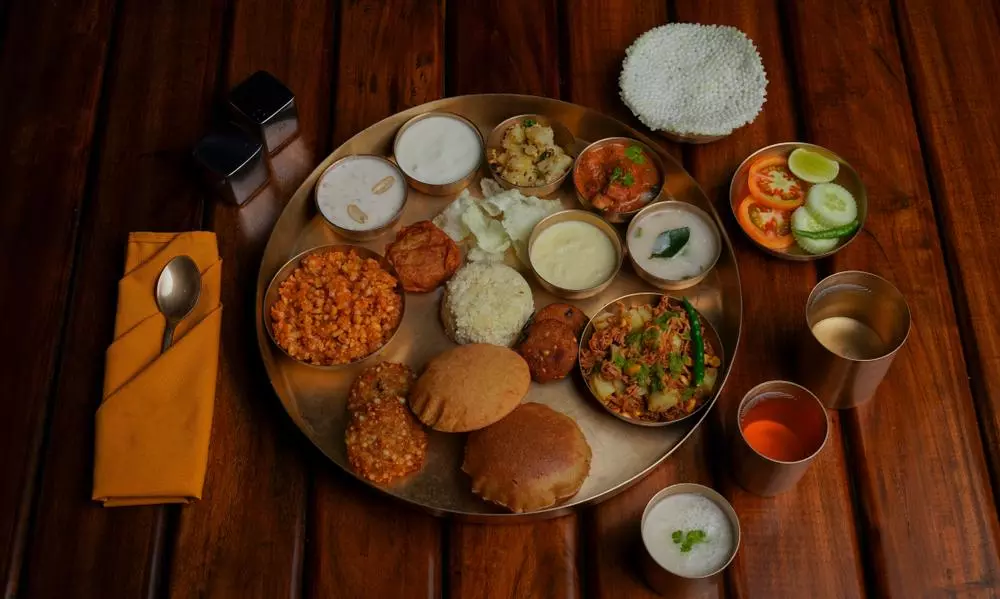This Independence Day, here's celebrating both rare and iconic dishes from all 29 states and union territories
Fasten your seatbelts and sit tight; this is going to be one exhilarating ride
- By Natasha KitturLoading...
- | 13 Aug 2022 10:00 AM IST
 X
X
India is celebrated for its diversity. We are a land of multiple cultures and histories, all bundled together, spread across 29 states and six union territories that have birthed multiple cuisines representative of the cultures prevalent among us. Right from Purani Delhi's classic nalli nihari or Kashmir's special kalari kulcha and South's erissery, to the tangy-sweet-spicy gorgeousness of the West's kombdi vade and a quintessential chorchori from the East, Indian food is like a never-ending horizon.
As we step into our 76th year as an Independent Democratic Republic, allow us to take you through the most iconic dishes from each state of our country.Sit tight and save this article, so you know what you need to try the next time you take a trip to any of the following places.
Puran Poli, Maharashtra
Puran poli is similar to a flatbread, and comes stuffed with a sweet lentil filling. To complement the sweetness of this dish amti (a type of curry or dal, with an acidic profile) is also prepared so one can enjoy the blend of sweet and sour flavours at the same time.
Ker Sangri, Rajasthan
Bringing together ker berries—a green berry that grows on thorny bushes in the desert regions of Rajasthan—and sangri beans, also known as desert beans, ker sangri is a tangy vegetable dish that is unique to the state of Rajasthan. The cooking process involves boiling the berries and beans first and then, adding it to tempered spices and finally mixing it with curd and raisins.
Ilish Macher Jhol, West Bengal
The land from where we got our beloved rasgullas and sondesh has many other recipes in its treasure trove that are still awaiting the due recognition. One such dish is the ilish macher jhol. A staple in West Bengal, this spicy hilsa curry is best enjoyed with steamed rice and a slice of lemon.
Undhiyu, Gujarat
Undhiyu literally translates to 'upside down'. This famous Gujarati dish employs the unique technique of cooking a melange of vegetables in an earthen pot, placed upside down inside a fire pit and requires a lot of patience. With raw bananas, potatoes, brinjal, peas, yam and other produce available in the months of November, December and January, undhiyu is the hallmark of Gujarati cuisine.
Chingudi Malai, Odisha
In this Odiya-style prawn curry, the seafood is prepped in a simple marinade of salt and turmeric and fried, before they are cooked with onions, tomatoes, chillies and bay leaves. The final step involves fresh coconut milk that lends the whole dish a rich and creamy texture.
Khorisa Maas, Assam
Khorisa or fermented, tender bamboo shoots, is an iconic ingredient from Assam. The ingredient is cooked along with fish and a few spices, to give you this special regional delicacy. Its standout feature is the fermented pickle, which helps lend a distinctive flavour to the dish.
Bai, Mizoram
Mizo bai is a rice-based dish studded with assorted vegetables. The signature dish is at its core, a stew prepared in a variety of ways, but mostly makes the best out of available seasonal produce, such as pork lard and vegetables.
Tehri, Uttar Pradesh
Tehri is a one-pot wonder. In it, plain rice is cooked along with vegetables like potatoes, tomatoes and onions, alongside spices.
Bhutte Ke Kees, Madhya Pradesh
Bhutte ka kees is Indore's gift to the country. The street-side snack makes use of corn kernels, milk, coconut, mustard and chillies and s the perfect companion to your hot cup of tea.
Hara Dhaniya Choliya, Haryana
A traditional dish in Haryana, the name hara dhaniya choliya may give you a little hint as to what goes in it. Green chickpeas (or hara chana) along with onions, carrots and spices for that extra kick is what makes it a household favourite. This winter special can be paired with hot rotis, or freshly steamed rice.
Makki di Roti and Sarson da Saag, Punjab
A Punjabi classic, sarson da saag is a dish consisting of blended greens,mustard greens, tender radish and l fenugreek and spinach leaves. Pair it with freshly made makki di roti, which is made with cornmeal, and enjoy with a generous dollop of ghee.
Dal Pitha, Bihar
Dal pitha, or rice dumplings are stuffed with seasoned lentils that could be either sweet or spicy. This traditional recipe from Bihar is usually paired with coriander, tomato or mint chutney and is downright delicious.
Gongura Mamsam, Andhra Pradesh
Gongura Mamsam is an Andhra special featuring mutton and red sorrel leaves or gongura akku).Typically, it is served with rice and ghee, which helps adjust the spice leves of the mamsam.
Thakkali Soru or Thakkali Sadam, Tamil Nadu
Thakkali soru or thakkali sadam is a tomato-based rice tempered with mustard and fenugreek seeds, chillies and pepper. The quick one-pot recipe is ideal for breakfast or to pack in a lunchbox.
Kalari Kulcha, Jammu & Kashmir
Kalari is a matured cheese that is native to Kashmir. It has a mild taste, quite similar to mozzarella. Kalari kulcha is a snack that employs this local cheese and great between mid-meals
Sarva Pindi, Telangana
Telangana's favourite, sarva pindi is a pancake comprising rice flour and peanuts. It is slow cooked in a deep pan, till crispy and the perfect savoury snack.
Mysore Pak, Karnataka
Mysore pak is a heavenly milk cake of sorts, cooked with three main ingredients—ghee, besan and sugar. While the traditional Mysore pak has a slightly crumbly and porous texture, you can opt for a soft and succulent version too. The trick lies in adding copious amounts of ghee and some water, providing the gram flour an adequate amount of liquid base to be cooked in.
Nalli Nahari, Delhi
Delhi, or rather Purani Delhi, is home to many spectacular dishes, rich in flavour and aroma. Of them, nihari is usually enjoyed as a breakfast on cold and chilly winters, comprising beef or mutton and a delicate balance of spices.
Tudkiya Bhath, Himachal Pradesh
Although little known for it, Himachal Pradesh is home to some real good food A Himachali special, tudkiya bhath is prepared with rice (or bhath) slow cooked with masoor dal, curd and indigenous spices like dagad phool (also known as kalpasi or blackstone, in English), alongside star anise and mace.
Rugra, Jharkhand
Rugra is a rare mushroom found in the state of Jharkhand, during the rains. A curry is made using these mushrooms, which is also known as putu. It serves as a great alternative to meat due to its taste and texture. This dish is enjoyed as a monsoon delight as it is also around the time of festivals.
Pehak, Arunachal Pradesh
Pehak is one among the most famous and spiciest dishes from Arunachal Pradesh. It is made by fermenting soybeans and then seasoning them with bhoot jolokia or ghost peppers. This can also be enjoyed as a side dish, in the form of a chutney.
Chicken Xacuti, Goa
Chicken xacuti is a curry made with red chillies, poppy seeds, coconut and onions. A special blend of spices is what lends to the flavour and aroma of this dish. When it comes to xacuti, it is said that it always tastes better the next day, as the meat absorbs the spices and flavour better. Try it with steamed rice, roti, or if you want to go Goan all the way, with poe, a Goan bread.
Chemmeen Curry, Kerala
Chemmeen curry, a Kerala style prawn curry, is made in a spicy coconut base with unripe mangoes, but during summers, tomatoes can also be used in its place.
Jadoh Rice, Meghalaya
An authentic dish from Meghalaya, jadoh is a meaty delicacy cooked in pork fat and a bunch of aromatic spices, akin to a biryani, but with the distinct flavours of the Northeast.
Samuthu, Nagaland
Samuthu is a spicy pork recipe that is native to the Sema tribe of Nagaland. A winter delicacy, this dish is slow-cooked at a low temperature and uses bamboo shoot vinegar. Traditionally, it is served with rice and a side of ginger chutney.
Churpi Soup, Sikkim
Churpi is a cheese indigenous to Sikkim and has a mild sour taste. When turned into a soup, it also employs a blend of spices and is a bonafide comfort food.
Bhangui, Tripura
Bhangui stands for banana leaf, which is actually used a medium of cooking, rather than being the star ingredient of the dish. Sun-dried rice is first cooked in clarified butter along with onion and ginger. This is then stuffed into banana leaves and boiled to absolut perfection. These rice-cakes are enjoyde with meat gravies and fish stews.
Pahari Gaderi Ki Sabji, Uttarakhand
Similar to arbi, gaderi is a pahari root vegetable cooked with sauteed jumboo (a rare herb with a strong flavour, found in Uttarakhand) and garlic. This dish can be eaten as part of your meal and also goes well with your evening tea as snacks.
Aamat, Chhattisgarh
Made with bamboo shoots, aamat (or kareel in Chhattisgarhi) is a tangy dish best enjoyed with rice or pej, a thick rice soup. A tribal delicacy from the Bastar region, it makes use of overnight-soaked black gram and bamboo shoots, which is cooked in a small amount of oil.
Kangshoi, Manipur
Famous in Manipur, kangshoi is a healthy,vegetable soup. Making the best of seasonal produce available and flavoured with garlic, cloves, maroi (winter leek), this stew is served with rice or fish.
Chilli Curry, Andaman and Nicobar Island
Chilli curry is a classic from the Andaman and Nicobar islands. Made with onions and tomatoes (the only two veggies in the entire dish) infused with loads of spices—green chillies, red chillies and chilli powder—the curry is intended to be hot and spicy. This dish is not only enjoyed by the natives but is also a tourist favourite.
Khambir, Leh Ladakh
Khambir is essentially a kind of bread, native to Ladakh. Found almost everywhere in the Union Territory, this brown bread with a thick crust is a much loved tea-time snack or can be eaten with chura (a type of cheese with a crumbly texture). Usually served for breakfast, along with butter tea (a salty kind of tea to which a dollop of butter is added) khambir is just one of those dishes that you will want to keep coming back to.
Mus Kevaab, Lakshadweep
One of the most sought after delicacies in Lakshadweep, mus kevaab comprises boneless fish chunks marinated in coconut paste, turmeric, chilli powder, coriander, cloves and other spices and then tossed and fried in a pan with onions, tomatoes and curry leaves. The dish can be found in a number of restaurants, but if you wish to make it at home, it tastes best with a plate of rice.
Now that you know of the iconic dishes from each state, which one are you going to try?

Natasha Kittur
Natasha Kittur is an aspiring writer. Her love for anything with cheese and spice is profound, but a white sauce pasta always tops her list. In her free time you will catch her reading or watching crime books and shows or go on and on about psychological experiments and theories. She aims to write a book in the fictional genre someday.


